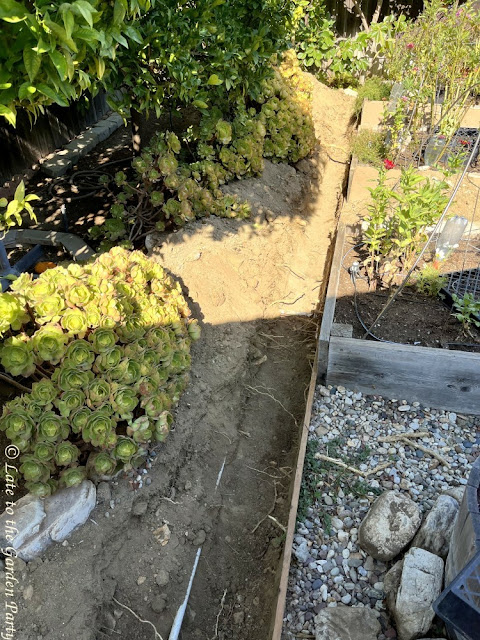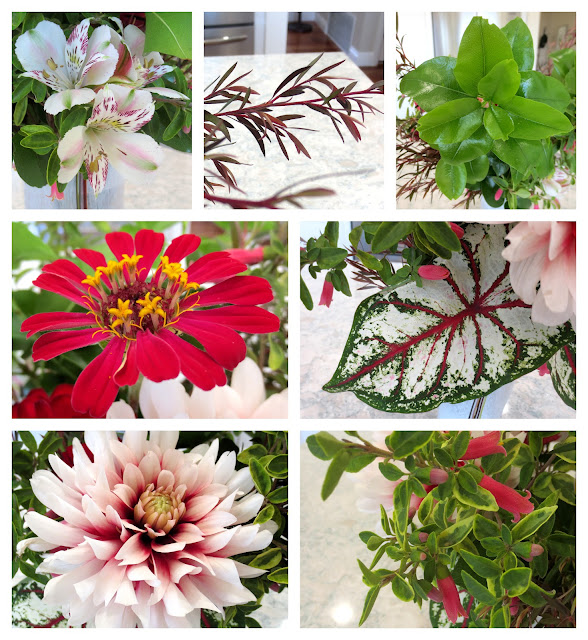After waiting two weeks for word on a date to replace 100+ feet of water pipe, we received a call late Tuesday afternoon advising us that, due to a delay on another project, the plumber's team could begin work the following morning. Luckily, I'd already cleaned out my compost bin and my husband had cleared out and bagged all the gravel in the affected areas. Unfortunately, I'd held off on pulling up the plants above the existing pipe, planning to take care of that closer to the project's start date. I thought I'd have more than a few hours prior notice.
 |
| This is a photo of the area in question taken for one of my "Coronavirus tourism" posts in 2020. Some of the plants have changed over the past 2 years but this is probably the clearest photo I have of the planted area affected by the plumbing work. In addition to a host of small succulents and bromeliads, the area included a large amount of flagstone, rock, a chiminea, and 2 large pots. |
My husband and I worked until well after sunset to get the rest of the work done and we were back at it again early the next morning. He lifted things he had no business lifting this soon after his surgery. I pulled up all the rock and flagstones I could but I needed his help with some of the heaviest items.
 |
| Miscellaneous stuff stored behind the garage had to be moved into the driveway |
 |
| I potted the plants worth saving and took cuttings of various succulents. I moved the bulbils I potted up after receiving an agave bloom stalk from a friend too. |
 |
| This is the area after it was cleared |
The plumber arrived with two crews right on schedule on Wednesday and promptly got to work. Trenches were dug, the first pipes were laid, and piles and piles of dirt were everywhere.
 |
| Trench extending from the city's water line at the street with the first section of the new pipe |
 |
| Another trench running the length of my cutting garden adjacent to the raised planters |
 | |
| The trench dug to contain the new pipe connected to the house |
 |
| This was a tricky bit as the plumbers had to tunnel under the concrete brick walkway into the bed on the other side to avoid taking out a section of the walkway |
The good news is that the plumbers were able to complete the job within two days instead of the three originally projected. Maybe that means my husband and I did more to clear the decks for the plumbers to work than they'd anticipated...
One of the biggest surprises was that a member of the plumbing crew was really into plants, especially orchids and succulents. He asked my husband for a tour of my lath (shade) house soon after he arrived. I gave him one of the variegated octopus agave bulbils (Agave vilmoriniana 'Stained Glass') on his first work day and he brought me several plants the next day. Of course, I needed to reciprocate so I came up with two bromeliad divisions, two agave pups, and a noID Gasteraloe to send him off with.
Before the plumbers left, they were kind enough to replace most of the flagstone we'd taken up before they arrived. Somehow ten of the middling and smaller pieces of flagstone didn't make it into their layout but it still gives me a good start in putting things back in order. I've already replaced two additional flagstones but, even as the current heatwaves wanes, it was too hot and sticky to do much more after they left. I'll get started with the remaining cleanup this weekend.
 |
| The bagged gravel needs to be spread over the dirt paths surrounding the raised planters in my cutting garden |
 |
| The remaining flagstones and all the rock formerly within and around the succulent-bromeliad bed needs to be replaced |
Weekend temperatures are supposed to be noticeably cooler. I hope so. I have a lot of work to do.
Best wishes for the weekend, however you're spending your time.
All material © 2012-2022 by Kris Peterson for Late to the Garden Party








































